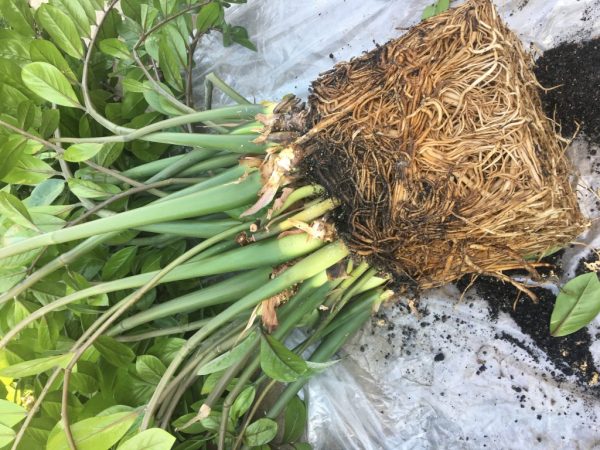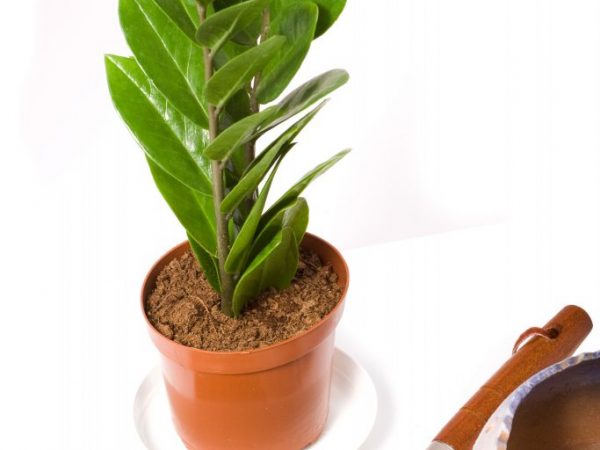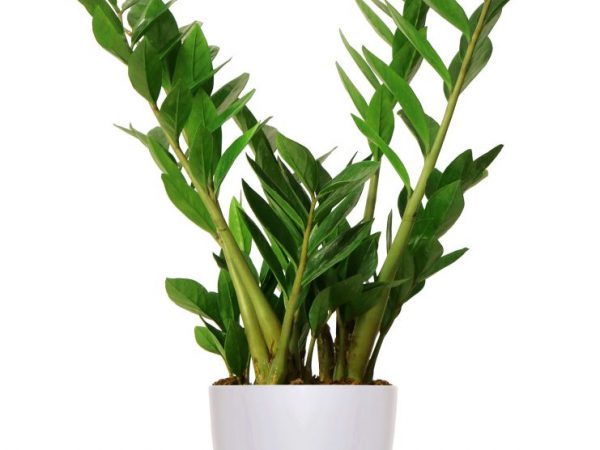Zamioculcas transplant - procedure scheme
Zamioculcas is a large exotic plant that has recently become an attraction in many houses. It is believed that culture brings material prosperity to its owner, but not only superstitions have become the reason for its popularity. The tree, despite its high decorative qualities, is quite unpretentious. However, for good development, it is necessary to provide him with proper care, including a timely transplant.

Zamioculcas transplant - procedure scheme
When to transplant
Do not rush to transplant Zamioculcas immediately after purchase.
When buying, it is not always possible to identify diseases and traces of the vital activity of pests, so the plant should be isolated from other indoor flowers.
On average, quarantine lasts no more than 3 weeks - during this time, the health status of the culture can be determined.
Watering the plant during this period is recommended only when necessary.
After the specified period, they move to a new soil.
The old one is not suitable for the active development of exotic, it is considered to be transportable and does not contain the necessary nutrients. In addition, it does not allow moisture to pass through well, which can lead to decay of the root system.
It is preferable to carry out the procedure in the spring, but if the purchase was made at another time of the year, you do not need to adhere to this rule.
Do not worry that Zamioculcas is blooming at this moment. The buds will most likely disappear, which will not bring any harm to the plant, on the contrary, it will give strength for a softer adaptation. The next stage will come at the right time.
Basic Rules
The complexity of the procedure is mainly due to a particularly sensitive root system, so the standard method in this case will not work. The best option is transshipment while preserving the earthy clod.
It is required to transplant a young plant into new soil annually, an adult specimen - once every 2 years.
It is necessary to take into account a number of features of Zamioculcas and adhere to the rules regarding the choice of planting pots, the composition of the soil and a favorable time for planting.
Soil and drainage
In its natural habitat, Zamioculcas grows on sandy and stony soils with an admixture of humus. At home, the soil mixture can be compiled independently by combining the following components:
- vegetable humus - 1 part;
- peat - 1 part;
- turf - 3 parts;
- leafy ground - 2 parts;
- river sand - 1 part.
The resulting soil mixture is thoroughly mixed and supplemented with a small amount of wood ash or coal, which acts as a preventive and protective agent against diseases.
If it is not possible to prepare the soil, you can use a specialized substrate for cacti and succulents, diluted 1/3 with coarse sand, perlite or vermiculite, which will improve the degree of soil aeration and its permeability.
It is not worthwhile to excessively increase the nutritional value of the soil - an overabundance of trace elements can provoke the spread of rot on the tubers of the culture.
In order to protect the flower as much as possible, a drainage layer is laid out in the container, the height of which should be at least 5 cm. River pebbles or expanded clay can be used as materials.
Pot selection

The size of the pot depends on the age of the plant.
Preference is given to low, wide pots, which provide a more convenient extraction of the earthen coma during the next transplant. Drainage holes are required.
The ideal material is plastic pots, which, if necessary, can be cut with scissors so as not to injure the sensitive roots of the exotic.
Some growers believe that this option is not always successful - during the growth process, the underground part is capable of deforming or cracking the container. Therefore, it is recommended to transplant into large clay pots, not covered with glaze, which will ensure maximum oxygen intake and the outflow of excess liquid.
The optimal size should exceed the previous one by about 15-20% or be 5 cm wider in diameter relative to the root system.
If you choose a container that is too large, there is a chance that the culture will stop growing due to the fact that it will devote all its energy to filling the empty space. There is also a risk of systematic stagnation of moisture, which negatively affects the health of the tree.
Timing
The optimal time for the procedure is winter and early spring. However, in the event of an emergency at another time, for example, in the summer in August or in the fall, it is not necessary to adhere to this rule.
Transplant technology
It is necessary to transplant Zamioculcas according to the instructions:
- The flower is carefully removed from the pot, if necessary, the latter is cut with a suitable tool or broken. It is not necessary to remove the earth, it is enough to slightly straighten the roots and stop the unproductive ones. If such manipulations cannot be carried out, the earthen ball is delicately rolled over a horizontal surface.
- If the tree is large and has several tubers, it can be propagated by dividing the rhizome. To do this, the underground part must be divided into a certain number of components, keeping roots and branches with growth points on each, and transplanted into different containers.
- The bottom of the pot is laid out by a third with drainage, the thickness of which depends on the dimensions of the pot. In this case, the layer should be at least 3-5 cm in height.
- A little soil is poured, a seedling is placed on top, the remaining voids are filled. The substrate is lightly tamped, leaving the top of the tubers above the surface.
- Moisturize. Mulch with expanded clay, small pebbles or sphagnum.
Care
In order for Zamioculcas to quickly take root after transplantation and get as strong as possible, it must be provided with correct care.
The pot is placed in a shaded warm place to stimulate the rooting process. Then they are transferred to a permanent place.
The tree can grow both on a well-lit windowsill and in a distant corner of the room. The latter is recommended for large specimens whose growth needs to be stopped.
When located on the south side, the plant is shaded during the hours of sun activity, because exposure to direct rays can provoke a burn.
Temperature
Zamioculcas is one of the thermophilic plants.
During the growing season, the regime must be maintained at a level of 25-30 degrees. In winter, the indicators drop to 15 degrees.
Humidity
It is allowed to systematically spray the foliage from the sprayer in order to eliminate the settled dust.
After - it is recommended to wipe the leaves, thereby removing excess moisture and cleaning the surface to normalize photosynthesis.
Additionally, Zamioculcas is placed monthly under a warm shower.
Watering

Excess moisture can cause roots to rot
One of the features of a green pet is its ability to accumulate liquid, so that it can do without additional moisture for a long time.
In the summer, irrigation should be plentiful, as the upper part of the substrate dries out, in the resting stage, the procedure is reduced to 2 times in 7 weeks.
Excessive soil moisture, coupled with a low temperature, leads to root rot and, as a result, to the threat of crop death.
If it is found for a long time in drought conditions, even if the foliage is falling, it is possible to save the plant - it should be watered in small portions, and when new young shoots appear, resume abundant irrigation.
Top dressing
The first time after transplanting, the tree is fed no earlier than 2 weeks. Mineral complexes for succulents are used as preparations. From autumn to spring, fertilization is completely stopped.
Possible problems
Despite the fact that it is quite simple to care for exotic Zamioculcas, a number of problems can arise during cultivation. Some of them are caused by incorrect transplantation.
| Problem | Cause | Decision |
| Loss of foliage | Excessive moisture / prolonged drought. | Systematize the irrigation system |
| High content of peat or clay in the substrate. | Transfer to the most suitable soil mixture | |
| Suspension of development | The plant grows in a pot that is too large, and therefore uses reserves for the development of the contents of the container by the roots | Transplanted into a container of the recommended size |
| The leaves turned yellow, became flabby | Decay of the root system. It should also be borne in mind that in adult plants, the leaves turn yellow and dry out during natural processes. | Reduce the amount of watering. If it was not possible to solve the problem in this way, they are transplanted into a new soil and the substrate is changed to a drier one. In the future, make sure that the moisture in the pallet does not stagnate. If necessary, the affected segments are stopped, the sections are disinfected with crushed activated carbon. |

